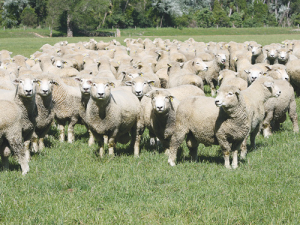Getting sheep shape at Pyramid Farm
The vineyards at Pyramid Farm in Marlborough’s Avon Valley have never been run of the mill, with plantings that follow the natural contours of the land, 250 metres above sea level.
 Reducing ewe mortality rates on farm by 2% could result in at least $28 million a year savings to the industry.
Reducing ewe mortality rates on farm by 2% could result in at least $28 million a year savings to the industry.
Reducing ewe mortality rates on farm by 2% could result in at least $28 million a year savings to the industry, says Kate Griffiths, at the Institute of Veterinary, Animal and Biomedical Sciences, Massey University.
An ongoing study is more accurately establishling mortality rates and the reasons for them.
One way to reduce culling rates may be to better identify udder traits that farmers can use to correctly identify which ewes to cull, she says.
A study is underway to look at a possible standardised scoring method on udder traits that farmers can use. Little scientific investigation has been done in this area for 40 years, Griffiths says in a paper to the NZ Veterinary Association conference.
Griffiths says there are about 20 million breeding ewes in New Zealand (Beef + Lamb NZ, 2015).
“If we assume an annual average onfarm mortality rate of 8% (1.6 million ewe deaths/year) and aim to reduce onfarm mortality to 6% (1.2m deaths/year), this will result in 400,000 fewer ewe deaths annually.
“Assuming ewes are conservatively valued at $70/ewe (Baker Associates, 2016) this equates to an extra $28m per year, and has not accounted for both feed savings and increased revenue from increased lamb sales.”
Griffiths says there is generally a lack of research and data related to longevity and wastage rates in NZ sheep flocks.
Ewe wastage results from onfarm mortality and premature culling -- the latter meaning a ewe is culled likely before the end of her productive lifespan, and is sent to slaughter via direct sale or via slaughter onfarm.
It is believed that onfarm ewe mortality lies in the range 5-12%, but this is not accurately known. This has a direct cost, in that the cull value of the ewe is not obtained and the potential for lambs is lost.
A main reason for premature culling of ewes from commercial flocks is their failure to rear lambs, having previously been identified as pregnant (wet-dry ewes). Poor or reduced milk production and impaired lactation performance may be contributing to these ewes being identified as wet-dry, but this is not accurately known.
Recent survey results indicate at least 75% of farmers were examining ewes’ udders looking for poor udder conformation or appearance, then culling them based on that assessment. However, there is no standardised scoring method NZ farmers can use that relates udder examination findings to a prognosis (i.e. likely ability to raise a lamb).
In fact, little scientific investigation of this has been done in the last 40 years. Therefore, ewes may be culled unnecessarily or, conversely, ewes unsuitable for breeding may be retained in the flock.
“We also do not know if udder characteristics change over the course of a production cycle (one year), and therefore do not currently know the best time to examine ewes’ udders. Udder examination is currently done at weaning, mainly for convenience.
“This study aims to identify udder traits related to the ability of a ewe to successfully rear a lamb and to identify udder traits that farmers can use to correctly identify which ewes to cull. This will enable more targeted ewe culling and a reduction of unnecessary lamb wastage.”
Referring to the overall study of mortality rates and reasons (now underway), Griffiths says 12,324 ewe hoggets are enrolled, all identified using electronic identification (EID) tags. Enrolled hoggets were 2010- and 2011-born (Farm A) and 2011-born (Farm B).
Farm A is in Waikato and runs a composite breed of Coopworth and East Friesian genetics; Farm B is located in Wairarapa and has Romney genetics.
About 85% of the enrolled hoggets were presented for breeding at 6-8 months of age, while the remainder were not bred until they were two-tooths.
The Push-Up Challenge, an event which combines mental health and fitness, is set to launch in New Zealand in 2026.
Last month's Agritechnica event led to a wide group of manufacturers celebrating successes when the 2026 Tractor of the Year Competition winners, selected by a panel of European journalists, were announced in Hanover Germany.
According to the latest Federated Farmers banking survey, farmers are more satisfied with their bank and less under pressure, however, the sector is well short of confidence levels seen last decade.
Farmer confidence has taken a slight dip according to the final Rabobank rural confidence survey for the year.
Former Agriculture Minister and Otaki farmer Nathan Guy has been appointed New Zealand’s Special Agricultural Trade Envoy (SATE).
Alliance Group has commissioned a new heat pump system at its Mataura processing plant in Southland.

OPINION: The release of the Natural Environment Bill and Planning Bill to replace the Resource Management Act is a red-letter day…
OPINION: Federated Farmers has launched a new campaign, swapping ‘The Twelve Days of Christmas’ for ‘The Twelve Pests of Christmas’ to…